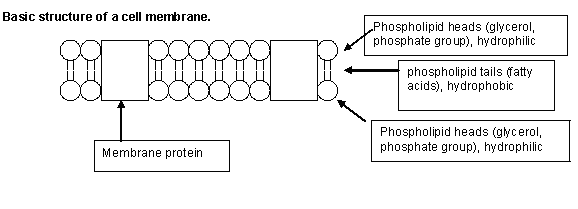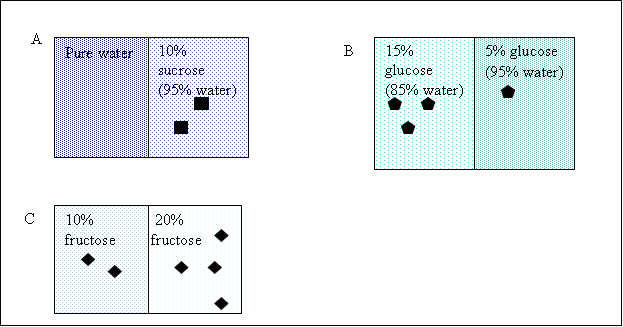

Recall that membranes have two major components: phospholipids arranged in a bilayer, and membrane proteins.

Click Here for a more elaborate picture of a cell membrane.
One of the functions of membranes is to control what passes into and out of the cell. In this module you will review mechanisms of membrane transport.
There are several different types of membrane transport, depending on the characteristics of the substance being transported and the direction of transport.
SIMPLE DIFFUSION
In simple diffusion, small noncharged molecules or lipid soluble molecules pass between the phospholipids to enter or leave the cell, moving from areas of high concentration to areas of low concentration (they move down their concentration gradient). Oxygen and carbon dioxide and most lipids enter and leave cells by simple diffusion.
Illustrations of simple diffusion.
|
|
||

|
Note that the arrows indicate that the substance is moving from where there is more of that substance to where there is less of it, and that the substances are passing between the phospholipids of the membrane. |
 |
OSMOSIS
Osmosis is a type of simple diffusion in which water molecules diffuse through a selectively permeable membrane from areas of high water concentration to areas of lower water concentration. (Note that the more particles dissolved in a solution, the less water there is in it, so osmosis is sometimes described as the diffusion of water from areas of low solute concentration to areas of high solute concentration).
Illustration of Osmosis. Assume that the membrane is permeable to water, but not to sucrose (represented by the small black squares). The sucrose molecules will not leave the cell because they cannot pass through the membrane. However, since there is less water on the side with the sucrose, water will enter the cell by osmosis.
Another way to describe the two solutions in the example of above is to use the terms hypertonic and hypotonic. A hypertonic solution has more solutes and less water than a hypotonic solution. So, in the example above, the solution inside the cell is hypertonic to the solution outside the cell. During osmosis, water moves from the hypotonic solution (more water, less solutes) to the hypertonic solution (less water, more solutes).
In each of the examples shown below, which of the solutions is hypertonic?

FACILITATED DIFFUSION
In facilitated diffusion, substances move into or out of cells down their concentration gradient through protein channels in the cell membrane. Simple diffusion and facilitated diffusion are similar in that both involve movement down the concentration gradient. The difference is how the substance gets through the cell membrane. In simple diffusion, the substance passes between the phospholipids; in facilitated diffusion there are a specialized membrane channels. Charged or polar molecules that cannot fit between the phospholipids generally enter and leave cells through facilitated diffusion.
Illustrations of facilitated diffusion.
|
|
Note that the substance is moving down its concentration gradient through a membrane protein (not between the phospholipids)

ACTIVE TRANSPORT
The types of membrane transport discussed so far
always involve substances moving down their concentration gradient. It is also
possible to move substances across membranes against their concentration
gradient (from areas of low concentration to areas of high concentration).
Since this is an energetically unfavorable reaction, energy is needed for this
movement. The source of energy is the breakdown of ATP. If the energy of ATP is
directly used to pump molecules against their concentration gradient, the
transport is called primary active transport.
|
Illustration of
primary active transport.
Note that the substance (indicated by the triangles) is being transported from the side of the membrane with little of the substance to the side of the membrane with a lot of the substance through a membrane protein, and that ATP is being broken down to ADP.
|
 |
In some cases, the use of ATP may be indirect. For example, if a cell uses ATP to pump out Na+ and then uses the Na+ concentration gradient to bring in glucose, the transport of glucose would be an example of secondary active transport.
On the left side of the picture below, a substance (represented by an X) is being transported from the inside of the cell to the outside even though there is more of that substance on the outside (indicated by the letter X being larger on the outside of the cell. This is primary active transport.
In the picture on the right side, substance S, already at higher concentration in the cell, is brought into the cell with substance X. Since S is being transported without the direct use of ATP, the transport of S is an example of secondary active transport. For substance X primary active transport of X is occurring. The high concentration of X outside the cell is being used to bring in substance S against its concentration gradient.

ENDOCYTOSIS AND EXOCYTOSIS: MOVEMENT OF LARGE PARTICLES
It is possible for large molecules to enter a cell by a process called endocytosis, where a small piece of the cell membrane wraps around the particle and is brought into the cell. If the particle is solid, endocytosis is also called phagocytosis. If fluid droplets are taken in, the processes is called pinocytosis.
Illustration of endocytosis. Note that the particle entered the cell surrounded by a piece of cell membrane.
The opposite of endocytosis is exocytosis. Cells use exocytosis to secrete molecules too large to pass through the cell membrane by any other mechanism.
Other Links and animations:
http://programs.northlandcollege.edu/biology/Biology1111/animations/transport1.html
For an animation of active transport, endocytosis, exocytosis, see:
http://www.wisc-online.com/objects/index_tj.asp?objid=AP11203
For more information on secondary active transport, check out: http://www.lib.mcg.edu/edu/eshuphysio/program/section1/1ch2/s1ch2_36.htm
DICHOTOMOUS KEY FOR CELL TRANSPORT

Click on the button above to open a problem solver to help you practice your understanding of membrane transport with the following examples:
1. A white blood cell engulfs a bacterium as you fight off an infection.
2. Carbon dioxide (a small uncharged gas molecule) enters the lungs (where it is less concentrated) from the blood (where it is more concentrated).
3. Cells of the stomach wall transport hydrogen ions through a ATP-dependent membrane protein to the inside of the stomach, producing a pH of 1.5.
The pH of the cytosol (fluid inside the cells) of stomach wall cells is approximately 7. (Recall that a low pH means high hydrogen ion concentrations).
4. The lung cells of a victim who drowned in fresh water are swollen due to water entering the cells.
5. Salivary gland cells produce the enzyme salivary amylase and secrete it into the salivary ducts to be delivered to the mouth.
6. A Paramecium (a single celled organism) swims into an area of salty water.. The Paramecium shrivels up as it loses water through its cell membrane.
7. Some bacteria use the energy of ATP to pump H+ out of their cells. They use the H+ concentration gradient to drive the transport of sugars into the cell
against their concentration gradients. What mechanism of transport best describes how the sugars are entering bacterial cells?
8. Some cells engulf droplets of extracellular fluid. What mechanism of transport would this be?